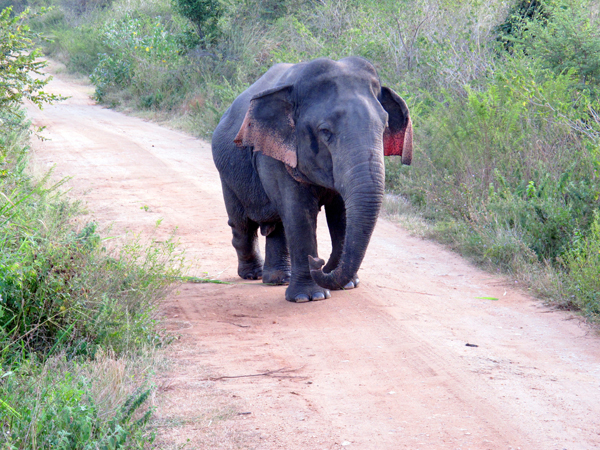A Dwarf Elephant With Outsized Attitude
First seen in 2013, a wild dwarf elephant in Sri Lanka, who is only five feet tall at the shoulder, has been sighted again–as pugnacious as ever.
By Vicki Croke

The dwarf elephant first documented in the wild in Sri Lanka in 2013 is only five feet tall at the shoulder. Photo: Brad Abbott
The world’s first documented wild dwarf elephant, who was seen briefly in 2013 before vanishing again, is alive and well, according to Pruthu Fernando, from the Centre for Conservation and Research, Rajagiriya, Sri Lanka.
The elephant, first observed in 2013 in Sri Lanka’s Udawalawe National Park, returned to the same area this year. It’s a relief, because he faces many challenges to his survival, even more than the larger elephants around him. But Fernando says the animal appears to be in good health.
At just five feet at the shoulder, the existence of the dwarf elephant surprised researchers. And so did his attitude.
Vicki spoke with Here & Now’s Jeremy Hobson and field biologist Pruthu Fernando about this unique elephant.
When the elephant was first observed he was actually picking on a much larger elephant. It was early on the morning of July 7 of 2013 on a road in a national park in Sri Lanka. Two elephants were “sparring” and the one with “short, stubby legs,” according to biologists appeared to be the aggressor. Both males showed signs of being in “musth,” a seasonal state in which a male’s testosterone levels can climb to 50 or even 100 times normal, making him combative.
[youtube=http://youtu.be/3fa0PGcCNJ8]
When the dwarf elephant reappeared this year, he was again full of fight, taking on another, much larger male. Video courtesy of UdawalaweElephants.
Photos and videos show that this startlingly short animal has a massive, typically “male” head—big, bony, and with a broad trunk base—and his body is the size of the other elephants around him. But it is very clear that he is much different than the other elephants.
In fact, he is unique.
He looks like the corgi version of an elephant. Writing in Gajah, the bi-annual scholarly journal of the IUCN/SSC Asian Elephant Specialist Group, Pruthu Fernando and other authors point out that “disproportionate dwarfism” is deliberately selected for some domesticated species. We see it in the shortened limbs of dachshunds and basset hounds in dogs, or munchkin cats.

When sparring, the dwarf elephant seems unfazed by the size of his opponents. Video still courtesy of UdawalaweElephants.
Various mutations can cause dwarfism, but in the wild, the authors write, such dwarf animals are unlikely to survive. A short-limbed predator would have trouble catching prey and a short-limbed prey animal would find it difficult to run faster than a predator.
As the article in Gaja says:
Dwarfism is unusual in wild animals. Individuals with disproportionate dwarfism are especially unlikely to survive in the wild as shorter limbs would impose severe fitness costs in predators or prey. As social mega-herbivores without predators, Asian elephants are one of the very few species in whom a dwarf phenotype may not be lethal. Here we report the first record of a free ranging adult wild animal—an Asian elephant (Elephas maximus), with disproportionate dwarfism.
The elephant himself is fascinating. We can’t tell how old he is exactly, but certain typical signs–such as the ears folding down–indicate he is a mature adult. And there are many other questions about him. How did he survive into adulthood? Right from the start, baby elephants suckle with their mouths because they don’t yet know how to control their trunks. They don’t have the skill. So how did this elephant reach his mother’s teats? He had to have gotten his mouth up high enough. Or did his mother, who would normally stand to feed a baby, lower herself?
Old gunshot wounds on his body appear as telltale lumps and indicate that he most likely has been fired on while raiding crops. A scar near the tip of his trunk shows that he survived a brush with a snare.
According to the Whitley Fund for Nature, human-elephant conflict is a big problem in Sri Lanka, claiming, on average, the lives of one person and three elephants every week.
[youtube=http://youtu.be/ji8A6SoPaJI]
Interesting to hear the biologist’s reaction during this short video when he first sees the dwarf elephant in 2013. Video courtesy of UdawalaweElephants.
In addition to tricky interactions with humans, how is he managing socially among other elephants? Sri Lankan elephants tend to be a pretty tall subspecies of Asian elephant ranging from about 6 feet at the shoulder to more than 11 feet. And there are about 1,000 of them in the Udawalawe National Park where the dwarf elephant was observed.
The paper’s authors say that “behaviourally the dwarf elephant appeared normal.”
Of the most recent sighting of the elephant, Fernando emailed: “We were able to observe him on a few days and get pics and video. Then he again went off outside the Park. Sadly this year he had a few more lumps indicative of gun shot injuries on him. However he seemed to be in good health. We will be looking for him again in June-July next year.”

